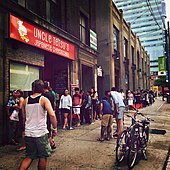
Issei are Japanese immigrants to countries in North America and South America. The term is used mostly by ethnic Japanese. Issei are born in Japan; their children born in the new country are nisei ; and their grandchildren are sansei.
Sansei is a Japanese and North American English term used in parts of the world to refer to the children of children born to ethnically Japanese emigrants (Issei) in a new country of residence, outside of Japan. The nisei are considered the second generation, while grandchildren of the Japanese-born emigrants are called Sansei. The fourth generation is referred to as yonsei. The children of at least one nisei parent are called Sansei; they are usually the first generation of whom a high percentage are mixed-race, given that their parents were (usually), themselves, born and raised in America.

Little Italy, sometimes referred to as College Street West, is a district in Toronto, Ontario, Canada. It is known for its Italian Canadian restaurants and businesses. There is also a significant Latin-Canadian and Portuguese-Canadian community in the area. The district is centred on a restaurant/bar/shopping strip along College Street, centred on College Street, imprecisely between Harbord Street and Dundas Street, and spreading out east and west between Bathurst Street and Ossington Avenue. It is contained within the larger city-recognized neighbourhood of Palmerston-Little Italy.
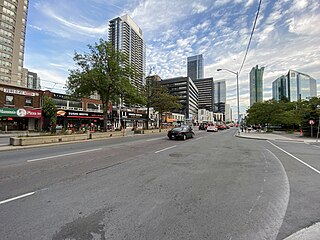
Willowdale is a neighbourhood in the city of Toronto, Ontario, Canada, located in the district of North York. It developed from three postal villages: Newtonbrook, Willowdale and Lansing.
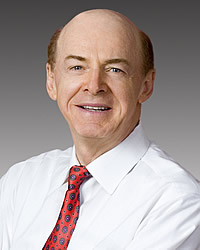
Tony Ruprecht is a former Canadian politician. His first elected position was as an alderman in the old Toronto City Council, in the late 1970s. He became a member of the Legislative Assembly of Ontario in 1981, and served in premier David Peterson's cabinet as minister without portfolio from 1985 to 1987. Ruprecht represented Toronto's Parkdale and then Davenport constituencies for the Liberal Party of Ontario for 30 years. On 5 July 2011, he announced that he was leaving politics and would not seek re-election in the October 2011 provincial election.

Buddhism is among the smallest minority-religions in Canada, with a very slowly growing population in the country, partly the result of conversion, with only 4.6% of new immigrants identifying themselves as Buddhist. As of 2021, the census recorded 356,975 or 0.8% of the population.
The Demographics of Montreal concern population growth and structure for Montreal, Quebec, Canada. The information is analyzed by Statistics Canada and compiled every five years, with the most recent census having taken place in 2021.
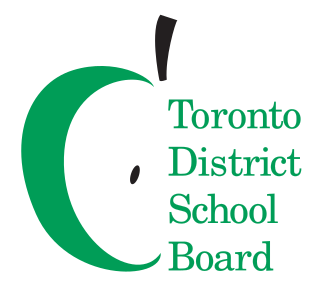
The Toronto District School Board (TDSB), formerly known as English-language Public District School Board No. 12 prior to 1999, is the English-language public-secular school board for Toronto, Ontario, Canada. The minority public-secular francophone, public-separate anglophone, and public-separate francophone communities of Toronto also have their own publicly funded school boards and schools that operate in the same area, but which are independent of the TDSB. Its headquarters are in the district of North York.
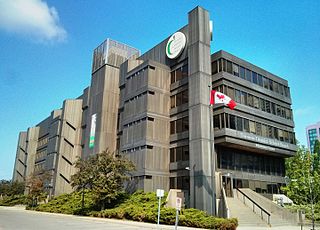
Education in Toronto is primarily provided publicly and is overseen by Ontario's Ministry of Education. The city is home to a number of elementary, secondary, and post-secondary institutions. In addition to those institutions, the city is also home to several specialty and supplementary schools, which provide schooling for specific crafts or are intended to provide additional educational support.
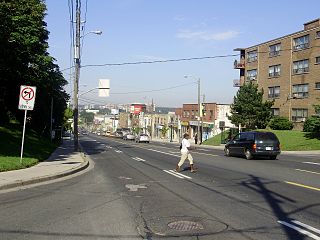
Silverthorn, often misspelled as Silverthorne, is a neighbourhood and former postal village in Toronto, Ontario, Canada. The approximate boundaries are the GO Transit Barrie line railway tracks to the east, Black Creek Drive and the CP railway line to the west and the former boundaries of the City of York to the north and south. The neighbourhood west of Keele Street is known as Keelesdale. For demographic purposes, the city breaks the area down into two neighbourhoods Keelesdale-Eglinton West, south of Eglinton, and Beechborough-Greenbrook north of Eglinton. It was originally a postal village to serve the then-agricultural York Township.

Steeles is a suburban neighbourhood in Toronto, Ontario, Canada. Steeles is located in the north-eastern part of Toronto in the former suburb of Scarborough. To the north is bordered by Steeles Avenue East, to the east by Kennedy Road, to the south by a hydro-electric transmission line and to the west by Victoria Park Avenue.
Jean Bessie Lumb,, née Wong (1919–2002) was the first Chinese Canadian woman and the first restaurateur to receive the Order of Canada for her community work. Most notably, she was recognized for her pivotal role in changing Canada’s immigration laws that separated Chinese families and for her contribution in saving Toronto's First Chinatown and Chinatowns in other cities.
Nisei is a Japanese-language term used in countries in North America and South America to specify the ethnically Japanese children born in the new country to Japanese-born immigrants. The Nisei are considered the second generation and the grandchildren of the Japanese-born immigrants are called Sansei, or third generation. Though nisei means "second-generation immigrant", it often refers to the children of the initial diaspora, occurring in the late 19th and early 20th centuries, and overlapping with the G.I. and silent generations.
Yonsei is a Japanese diasporic term used in countries, particularly in North America and in Latin America, to specify the great-grandchildren of Japanese immigrants (Issei). The children of Issei are Nisei. Sansei are the third generation, and their offspring are Yonsei. For the majority of Yonsei in the Western hemisphere, their Issei ancestors emigrated from Japan between the 1880s and 1924.
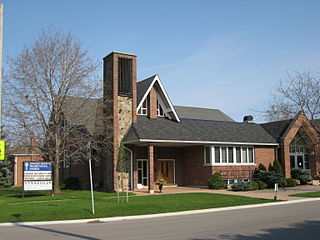
Armour Heights is a neighbourhood in Toronto, Ontario, Canada, in the district of North York. It is bounded by Wilson Avenue to the south, Bathurst Street to the west, and the west branch of the Don River to the north and east. Highway 401 cuts through the centre of the neighbourhood.
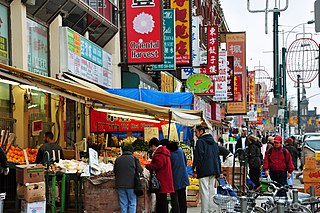
The Chinese Canadian community in the Greater Toronto Area was first established around 1877, with an initial population of two laundry owners. While the Chinese Canadian population was initially small in size, it dramatically grew beginning in the late 1960s due to changes in immigration law and political issues in Hong Kong. Additional immigration from Southeast Asia in the aftermath of the Vietnam War and related conflicts and a late 20th century wave of Hong Kong immigration led to the further development of Chinese ethnic enclaves in the Greater Toronto Area. The Chinese established many large shopping centres in suburban areas catering to their ethnic group. There are 679,725 Chinese in the Greater Toronto Area as of the 2021 census, second only to New York City for largest Chinese community in North America.
Toronto's Cambodian population consists of 6,430 ethnic Cambodian people. In 1999, 98% of Cambodians in Toronto identified themselves as Khmer people.
Toronto has a significant population of Vietnamese Canadians. Toronto is about 1.5% Vietnamese.
South Asian Canadians in the Greater Toronto Area form 19% of the region's population, numbering 1.2 million as of 2021. Comprising the largest visible minority group in the region, Toronto is the destination of over half of the immigrants coming from India to Canada, and India is the single largest source of immigrants in the Greater Toronto Area. South Asian Canadians in the region also include significant Pakistanis, Bangladeshis, Sri Lankans, and Nepalis, all representing several different ethnolinguistic backgrounds.
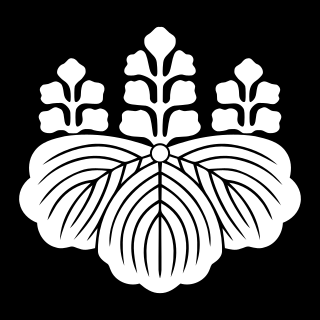
Toyotomi Tomo or Nisshu-ni was a Japanese noble woman member from the aristocrat samurai family, Toyotomi clan, from the Sengoku period to the early Edo period. She was the sister of Toyotomi Hideyoshi the second "Great Unifier" of Japan. She was the daughter of Ōmandokoro, the matriarch of Toyotomi clan, and mother of Toyotomi Hidekatsu, Toyotomi Hidetsugu and Toyotomi Hideyasu. Tomo was the founder of Zensho-ji Temple. She was one of the last survivors of the Toyotomi clan; the clan was exterminated after the Siege of Osaka.
